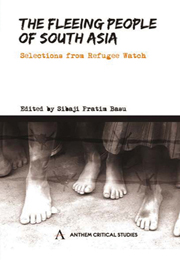Book contents
- Frontmatter
- Contents
- Acronyms and Abbreviations
- Foreword by Ranabir Samaddar
- Preface
- ETHICAL ISSUES
- LAWS
- SOUTH ASIA
- INDIA
- GENDER
- Introduction
- Refugee Repatriation: A Politics of Gender
- Families, Displacement, Partition
- Widows of Brindaban: Memories of Partition
- Agony Continues: Refugee Women of Bhutan
- Dislocating Women and Making the Nation
- Geder, Media and the Tsunami
- Why Should we Listen to Her?
- Women, Trafficking and Statelessness
- The Bar Dancer and the Trafficking Migrant: Globalization and Subaltern Existence
- INTERVIEW/CORRESPONDENCE
- REPRESENTATIONS
- Index
Women, Trafficking and Statelessness
from GENDER
Published online by Cambridge University Press: 05 March 2012
- Frontmatter
- Contents
- Acronyms and Abbreviations
- Foreword by Ranabir Samaddar
- Preface
- ETHICAL ISSUES
- LAWS
- SOUTH ASIA
- INDIA
- GENDER
- Introduction
- Refugee Repatriation: A Politics of Gender
- Families, Displacement, Partition
- Widows of Brindaban: Memories of Partition
- Agony Continues: Refugee Women of Bhutan
- Dislocating Women and Making the Nation
- Geder, Media and the Tsunami
- Why Should we Listen to Her?
- Women, Trafficking and Statelessness
- The Bar Dancer and the Trafficking Migrant: Globalization and Subaltern Existence
- INTERVIEW/CORRESPONDENCE
- REPRESENTATIONS
- Index
Summary
It is estimated that around 27 million people today are living in conditions similar to that of slavery and human trafficking has become a global industry worth $ 12 billion a year. It is even more baffling to note that twice as many people are enslaved today than during the days of the African slave trade. How can that be and what exactly is human trafficking? Human trafficking can be described as the forced movement of people for purposes of labour, such as prostitution and other kinds of work, including domestic work. If one looks at the history of the term ‘trafficking’ it can be traced back to ‘white slave trade’. Before the great wars it meant the coercion or transportation of Caucasian women to the colonies to service white male officers. From 1904 there were efforts to stop ‘white slave trade’ leading to the Convention for the Suppression of the Traffic in Person and the Exploitation of Others in 1949. It is the Palermo Protocol to the United Nations Convention against Transnational Organized Crime that made trafficking in persons an international criminal offence in the year 2000. The Protocol was drafted to meet all aspects of trafficking, whether for sexual or labour exploitation. The Protocol's objectives are to prevent trafficking, punish traffickers and protect victims. The Protocol urges states to criminalize trafficking. It also specifies the activities, means and purposes that constitute the offence. The important features of the Protocol are:
- Type
- Chapter
- Information
- The Fleeing People of South AsiaSelections from Refugee Watch, pp. 343 - 354Publisher: Anthem PressPrint publication year: 2009



